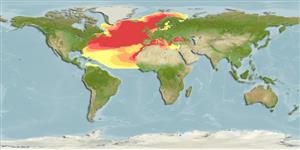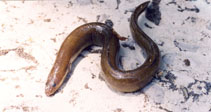把你的觀察加入 Fish Watcher
| Native range | All suitable habitat | Point map | Year 2050 |

|
| This map was computer-generated and has not yet been reviewed. |
| Anguilla anguilla AquaMaps Data sources: GBIF OBIS |
上傳你的 相片 和 影像
Pictures | Videos | Stamps, coins, misc. | Google 影像Anguilla anguilla
Picture by V. Tachos & D. Bobori
Pictures | Videos | Stamps, coins, misc. | Google 影像Anguilla anguilla
Picture by V. Tachos & D. Bobori
France country information
Common names:
Angèle, Anguiello, Anguielo
Occurrence: native
Salinity: freshwater
Abundance: | Ref:
Importance: commercial | Ref:
Aquaculture: commercial | Ref: FAO Fishery Information, Data and Statistics Service, 1993
Regulations: | Ref:
Uses: live export: yes;
Comments: Known from the Gironde basin (Ref. 51442) and Mont Saint-Michel Bay (Ref. 38302). It occurs throughout France but is diminishing in number. The elvers are being rared in captivity. Also Ref. 6125, 9988. Status of threat: Vulnerable (Ref. 11941, 30578, 74334). Also Ref. 38302.
National Checklist:
Country Information: https://www.cia.gov/library/publications/resources/the-world-factbook/geos/fr.html
National Fisheries Authority:
Occurrences: Occurrences Point map
Main Ref: Béarez, P., P. Pruvost, É. Feunteun, S. Iglésias, P. Francour, R. Causse, J. De Mazières, S. Tercerie and N. Bailly, 2017
National Database:
Occurrence: native
Salinity: freshwater
Abundance: | Ref:
Importance: commercial | Ref:
Aquaculture: commercial | Ref: FAO Fishery Information, Data and Statistics Service, 1993
Regulations: | Ref:
Uses: live export: yes;
Comments: Known from the Gironde basin (Ref. 51442) and Mont Saint-Michel Bay (Ref. 38302). It occurs throughout France but is diminishing in number. The elvers are being rared in captivity. Also Ref. 6125, 9988. Status of threat: Vulnerable (Ref. 11941, 30578, 74334). Also Ref. 38302.
National Checklist:
Country Information: https://www.cia.gov/library/publications/resources/the-world-factbook/geos/fr.html
National Fisheries Authority:
Occurrences: Occurrences Point map
Main Ref: Béarez, P., P. Pruvost, É. Feunteun, S. Iglésias, P. Francour, R. Causse, J. De Mazières, S. Tercerie and N. Bailly, 2017
National Database:
Common names from other countries
分類 / Names 俗名 | 同種異名 | Catalog of Fishes(屬, 種) | ITIS | CoL | WoRMS | Cloffa
Teleostei > Anguilliformes (Eels and morays) 鰻鱺目 (Eels and morays) > Anguillidae (Freshwater eels) 鰻鱺科 (Freshwater eels)
Etymology: Anguilla: Latin, anguilla, .-ae = eel (Ref. 45335).
More on author: Linnaeus.
Etymology: Anguilla: Latin, anguilla, .-ae = eel (Ref. 45335).
More on author: Linnaeus.
Environment: milieu / climate zone / depth range / distribution range 生態學
海洋; 淡水; 半鹹淡水 居於水底的; 降海洄游 (Ref. 51243); 深度上下限 0 - 700 m (Ref. 54218). 溫帶; 4°C - 20°C (Ref. 2059); 75°N - 8°N, 82°W - 50°E (Ref. 42249)
分布 國家 | FAO區域 | 生態系 | 發現紀錄 | Point map | 簡介 | Faunafri
Atlantic Ocean: Atlantic coast from Scandinavia to Morocco; Baltic, Black and Mediterranean Seas; rivers of North Atlantic, Baltic and Mediterranean seas (Ref. 172, Ref. 51442). Continuous introductions to Asia and South and Central America. Spawning area in western Atlantic (Sargasso Sea). At least one country reports adverse ecological impact after introduction. Recent genomic DNA studies show that the European eel exhibits isolation by distance, implying that non-random mating and restricted gene flow among eels from different location exists (Ref. 43723). The existence of 3 genetically distinct sub-populations is suggested: a Northern European subpopulation (consisting mainly of the Icelandic stocks); a Western European subpopulation (including the Baltic, the Mediterranean and Black Sea); a Southern sub-population (including stocks of Morocco) (Ref. 43723, 89139).
大西洋: 來自斯堪的那維亞半島到摩洛哥與北大西洋,波羅的海與地中海的河的大西洋的海岸.(參考文獻 172, 參考文獻 51442) 對亞洲與南方與中美洲的連續介紹, 但是不再製造。 在大西洋西部 (藻海 ) 中產卵區域。 也分佈沿著歐洲從黑海到白海的海岸。 至少一個國家報告引入後的不利的生態衝擊。 最近的染色體基因組研究顯示歐洲的鰻魚展現距離的隔離, 暗示那個非隨機交配與來自不同的地點的在鰻魚之中的被限制的基因流動存在.(參考文獻 43723)
大西洋: 來自斯堪的那維亞半島到摩洛哥與北大西洋,波羅的海與地中海的河的大西洋的海岸.(參考文獻 172, 參考文獻 51442) 對亞洲與南方與中美洲的連續介紹, 但是不再製造。 在大西洋西部 (藻海 ) 中產卵區域。 也分佈沿著歐洲從黑海到白海的海岸。 至少一個國家報告引入後的不利的生態衝擊。 最近的染色體基因組研究顯示歐洲的鰻魚展現距離的隔離, 暗示那個非隨機交配與來自不同的地點的在鰻魚之中的被限制的基因流動存在.(參考文獻 43723)
Length at first maturity / 大小 / 重量 / 年齡
Maturity: Lm 55.0, range 45 - 65 cm
Max length : 122 cm TL 雄魚/尚未辨別雌雄; (Ref. 88166); 133.0 cm TL (female); common length : 35.0 cm TL 雄魚/尚未辨別雌雄; (Ref. 6125); common length :50 cm TL (female); 最大體重: 6.6 kg (Ref. 39903); 最大體重: 6.6 kg; 最大年齡: 23 年 (Ref. 106807)
Max length : 122 cm TL 雄魚/尚未辨別雌雄; (Ref. 88166); 133.0 cm TL (female); common length : 35.0 cm TL 雄魚/尚未辨別雌雄; (Ref. 6125); common length :50 cm TL (female); 最大體重: 6.6 kg (Ref. 39903); 最大體重: 6.6 kg; 最大年齡: 23 年 (Ref. 106807)
簡短描述 檢索表 | 型態特徵 | 形態測量圖
背棘 (總數) : 0; 臀棘: 0; 脊椎骨: 110 - 120. Elongated, anguilliform body (Ref. 51442), cylindrical anteriorly, somewhat compressed posteriorly (Ref. 6125). Lower jaw slightly longer and projecting (Ref. 6125, Ref. 51442). Gill openings small and vertical, restricted to the sides (Ref. 6125). Elongated dorsal and anal fins, confluent with caudal fin (Ref. 6125, Ref. 51442), forming one unique fin from the anus to the middle of the back with minimum 500 soft rays (Ref. 40476). Dorsal fin origin far behind pectoral fins; anal fin origin slightly behind anus, well back from origin of dorsal fin (Ref. 6125). Pelvic fins absent (Ref. 2196, Ref. 51442). Greenbrown colored (Ref. 51442).
延長的, 鰻魚狀的身體 (參考文獻 51442), 前部圓柱狀, 後面略微側扁.(參考文獻 6125) 下頜些微比較長與突出的.(參考文獻 6125, 參考文獻 51442) 鰓裂小而垂直的, 侷限於側邊.(參考文獻 6125) 延長的背鰭與臀鰭, 與尾鰭匯和鰭 (參考文獻 6125,參考文獻 51442), 形成一個獨特的鰭從肛門到背部中央最少有 500個軟鰭條。 (參考文獻 40476) 背鰭起點在胸鰭後方遠處; 臀鰭起源些微地在肛門後面, 湧出來自背鰭起點的背面.(參考文獻 6125) 腹鰭不存在。 (參考文獻 2196, 參考文獻 51442) 綠褐色的.(參考文獻 51442)
延長的, 鰻魚狀的身體 (參考文獻 51442), 前部圓柱狀, 後面略微側扁.(參考文獻 6125) 下頜些微比較長與突出的.(參考文獻 6125, 參考文獻 51442) 鰓裂小而垂直的, 侷限於側邊.(參考文獻 6125) 延長的背鰭與臀鰭, 與尾鰭匯和鰭 (參考文獻 6125,參考文獻 51442), 形成一個獨特的鰭從肛門到背部中央最少有 500個軟鰭條。 (參考文獻 40476) 背鰭起點在胸鰭後方遠處; 臀鰭起源些微地在肛門後面, 湧出來自背鰭起點的背面.(參考文獻 6125) 腹鰭不存在。 (參考文獻 2196, 參考文獻 51442) 綠褐色的.(參考文獻 51442)
Facultative air-breathing (Ref. 126274); Inhabits all types of benthic habitats from streams to shores of large rivers and lakes. Naturally found only in water bodies connected to the sea (Ref. 59043). Territorial and solitary species; 'schools' of young eels which are observed from time to time are a mass response to outward conditions and not of active assembling (Ref. 172). Amphihaline (Ref. 51442). Migrates to the depths of the Sargasso Sea to spawn (Ref. 172, 51442). Eel larvae (leptocephali) are transparent ribbon-like. They are brought to the coasts of Europe by the Gulf Stream in 7 to 11 months time (Ref. 51442) and can last for up to 3 years (Ref. 8994). They are transformed into glass eels (6-8 cm length, cylindrical in shape and transparent to slightly pigmented in colour). They enter the estuaries and colonize rivers and lakes (Ref. 11941, 51442); some individuals remain in estuaries and coastal waters to grow into adults (Ref. 88171). The glass eel stage is followed by a long feeding period (from the yellow to the silver eel stage) lasting 6-12 years in males (Ref. 6125) and 9-20 years in females (Ref. 6125). Yellow and silver eels are benthic, found under stones, buried in the mud or in crevices (Ref. 89138). Yellow eels eventually lose their pigmentation, becoming dark dorsally and silver ventrally (called silver eels). Silver eels are also characterized by a clear contrasting black lateral line and enlarged eyes (Ref. 6125). At the end of their growth period, they become sexually mature, migrate to the sea and cover great distances during their spawning migration (5,000-6,000 km); with extensive daily vertical migrations between 200 m at night and 600 m during day time, possibly for predator avoidance (Ref. 89140). Gametogenesis occurs entirely during spawning migration. Average life span is usually 15-20 years (Ref. 88171). Male eels can grow up to 50 cm TL (Ref. 39903). Occurs at temperatures ranging from 0-30°C (Ref. 172). Its food includes virtually the whole aquatic fauna (freshwater as well as marine) occurring in the eel's area, augmented with animals living out of water, e.g. worms (Ref. 172). Best temperature for making eels sexually mature is 20-25°C (Ref. 35388). Sensitive to weak magnetic fields (Ref. 89141, 89142). Their high fat content and benthic feeding habits in continental waters make them vulnerable to the bioaccumulation of pollutants, such as heavy metals and organic contaminants, that may result in organ damage and impaired migration capability (Ref. 82710) and lowered genetic variability (Ref. 82711). Review of information supports the view that the European eel population as a whole has declined in most areas, the stock is outside safe biological limits and current fisheries not sustainable (Ref. 82712). Obvious decreasing of the stocks for all the continental native distribution area (Ref. 40476). Utilized fresh, dried or salted, smoked and frozen; can be fried, boiled and baked (Ref. 9988).
Amphihaline 種 (參考文獻 51442), 迴游到深度藻海 產卵.(參考文獻 172,51442) 產卵發生於在藻海 的冬季末與春天.(參考文獻 35112) 狹首型幼魚仔魚在 7 到 11個月內被帶歐洲的到海岸藉由墨西哥灣流時間 (參考文獻 51442) 而且能持續超過 3 年。 (參考文獻 8994) 他們被轉換成鰻苗, 進入河口而且移殖至大陸的水域.(參考文獻 51442) 他們在遷進之前發育成小的鰻魚淡水流域。 (參考文獻 11941) 幼鰻度過他們的成長期在淡水中, 雄性 6-12 年以來, 雌性 9-20 年, 在結束他們的銳變之前.(參考文獻 172,51442) 在他們的成長時期結束的時候,他們性成熟了,而且鰻魚迴游到海洋在那裡它們被棲息於的深水域。 成魚不進食在迴游到海洋的時候。 完全地形成配子在朝向藻海 迴游的時候。 它發生於溫度範圍從 0-30個 ° C. 一個個人主義者在它所有的階段中。 鰻苗與幼鰻的 '魚群' 在河口那是時常觀察,而且河活躍的集合是對向外的環境一個大規模的回應而不是。 它的食物事實上包括整個的水生出現在鰻魚的區域的動物相 (淡水以及海洋), 增大的具有動物離開水面, 例如蠕蟲.(參考文獻 172) 在年約 6-30 年,鰻魚開始歷經一個顯著的成列改變, 頭部變成尖, 背部表皮變黑, 當那在腹面上變成有銀色光澤的時候,眼被增大。 使鰻魚性成熟的最好溫度是 20-25 °C 。 (參考文獻 35388) 最近的染色體基因組研究顯示歐洲的鰻魚展現距離的隔離, 暗示那個非隨機交配與來自不同的地點的在鰻魚之中的被限制的基因流動存在.(參考文獻 43723) 生鮮使用, 乾燥或鹽醃, 煙燻與冷凍的; 能被油炸, 煮沸而且燒烤。 (參考文獻 9988) 明顯的為所有的大陸分布區域分枝漸減。 次級保育類動物.(參考文獻 40476)在泥或裂隙中,他們生活在底部上,在石頭下面。
Amphihaline 種 (參考文獻 51442), 迴游到深度藻海 產卵.(參考文獻 172,51442) 產卵發生於在藻海 的冬季末與春天.(參考文獻 35112) 狹首型幼魚仔魚在 7 到 11個月內被帶歐洲的到海岸藉由墨西哥灣流時間 (參考文獻 51442) 而且能持續超過 3 年。 (參考文獻 8994) 他們被轉換成鰻苗, 進入河口而且移殖至大陸的水域.(參考文獻 51442) 他們在遷進之前發育成小的鰻魚淡水流域。 (參考文獻 11941) 幼鰻度過他們的成長期在淡水中, 雄性 6-12 年以來, 雌性 9-20 年, 在結束他們的銳變之前.(參考文獻 172,51442) 在他們的成長時期結束的時候,他們性成熟了,而且鰻魚迴游到海洋在那裡它們被棲息於的深水域。 成魚不進食在迴游到海洋的時候。 完全地形成配子在朝向藻海 迴游的時候。 它發生於溫度範圍從 0-30個 ° C. 一個個人主義者在它所有的階段中。 鰻苗與幼鰻的 '魚群' 在河口那是時常觀察,而且河活躍的集合是對向外的環境一個大規模的回應而不是。 它的食物事實上包括整個的水生出現在鰻魚的區域的動物相 (淡水以及海洋), 增大的具有動物離開水面, 例如蠕蟲.(參考文獻 172) 在年約 6-30 年,鰻魚開始歷經一個顯著的成列改變, 頭部變成尖, 背部表皮變黑, 當那在腹面上變成有銀色光澤的時候,眼被增大。 使鰻魚性成熟的最好溫度是 20-25 °C 。 (參考文獻 35388) 最近的染色體基因組研究顯示歐洲的鰻魚展現距離的隔離, 暗示那個非隨機交配與來自不同的地點的在鰻魚之中的被限制的基因流動存在.(參考文獻 43723) 生鮮使用, 乾燥或鹽醃, 煙燻與冷凍的; 能被油炸, 煮沸而且燒烤。 (參考文獻 9988) 明顯的為所有的大陸分布區域分枝漸減。 次級保育類動物.(參考文獻 40476)在泥或裂隙中,他們生活在底部上,在石頭下面。
Life cycle and mating behavior 成熟度 | 繁殖 | 產卵場 | 卵 | 孕卵數 | 仔魚
Catadromous species. When sexual maturity is reached they leave the river. Spawning migrations occur mainly during the second half of the year but have been observed year-round, usually commencing during dark nights (Ref. 172). Maturity is obtained during the spawning migration (Ref. 88171). Actual spawning has never been observed but is believed to occur solely in the Sargasso Sea between March and June (Ref. 89144). After spawning (at 600 m depth) adults die. Sigmund Freud described the testicles of eel (Ref. 72449).大西洋: 來自斯堪的那維亞半島到摩洛哥與北大西洋,波羅的海與地中海的河的大西洋的海岸.(參考文獻 172, 參考文獻 51442) 對亞洲與南方與中美洲的連續介紹, 但是不再製造。 在大西洋西部 (藻海 ) 中產卵區域。 也分佈沿著歐洲從黑海到白海的海岸。 至少一個國家報告引入後的不利的生態衝擊。 最近的染色體基因組研究顯示歐洲的鰻魚展現距離的隔離, 暗示那個非隨機交配與來自不同的地點的在鰻魚之中的被限制的基因流動存在.(參考文獻 43723)
主要參考資料
Upload your references | 參考文獻 | 合作者 | 合作者
Deelder, C.L., 1984. Synopsis of biological data on the eel, Anguilla anguilla (Linnaeus, 1758). FAO Fish. Synop. (80, Rev. 1):73 p. (Ref. 172)
對人類具威脅
潛能有害之物
人類使用
漁業: 商業性; 養殖: 商業性; 游釣魚種: 是的
FAO(Aquaculture systems: 產生, 魚種描繪; 漁業: 產生, 魚種描繪; publication : search) | FIRMS (Stock assessments) | FishSource | 周邊海洋
更多資訊
Population dynamics
成長參數
Max. ages / sizes
Length-weight rel.
Length-length rel.
長度-頻率
Mass conversion
入添量
豐度
成長參數
Max. ages / sizes
Length-weight rel.
Length-length rel.
長度-頻率
Mass conversion
入添量
豐度
Physiology
Body composition
Nutrients
耗氧量
游泳類型
游泳速度
Visual pigments
Fish sound
Diseases & Parasites
Toxicity (LC50s)
Body composition
Nutrients
耗氧量
游泳類型
游泳速度
Visual pigments
Fish sound
Diseases & Parasites
Toxicity (LC50s)
工具
Bio-Quiz | E-book | 野外調查 | 長度- 頻率 Wizard | 生活- 歷史的工具 | 分布圖 | Classification Tree
| Catch-MSY |
特別的報告
下載 XML
網路資源
Alien/Invasive Species database | Aquatic Commons | BHL | Cloffa | BOLDSystems | Websites from users | 檢查 FishWatcher | CISTI | Catalog of Fishes(屬, 種) | DiscoverLife | DORIS | ECOTOX | Faunafri | Fishtrace | GenBank(基因組, 核甘) | GloBI | GOBASE | | Google Books | Google Scholar | Google | IGFA World Record | MitoFish | 國家資料庫 | OsteoBase(skull, spine) | Otolith Atlas of Taiwan Fishes | 公眾的水族館 | PubMed | Reef Life Survey | Scirus | SeaLifeBase | 樹狀分類階層 | Wikipedia(去, 搜尋) | World Records Freshwater Fishing | 動物學的記錄
Estimates based on models
Preferred temperature (Ref. 115969): 3 - 14.5, mean 7.9 (based on 1203 cells).
Phylogenetic diversity index (Ref. 82804): PD50 = 0.5000 [Uniqueness, from 0.5 = low to 2.0 = high].
Bayesian length-weight: a=0.00095 (0.00084 - 0.00108), b=3.17 (3.13 - 3.21), in cm Total Length, based on LWR estimates for this species (Ref. 93245).
營養階層 (Ref. 69278): 3.6 ±0.3 se; based on diet studies.
回復力 (Ref. 120179): 低的, 最小族群倍增時間4.5 - 14 年 (K=0.1; tm=6-30; tmax=23).
Prior r = 0.20, 95% CL = 0.13 - 0.29, Based on 2 full stock assessments.
Fishing Vulnerability (Ref. 59153): High vulnerability (64 of 100).




